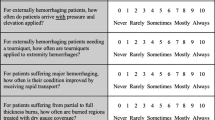Abstract
Nepal loses about 530,000 disability adjusted life years (DALYs) per year to injury, predominantly due to falls. It takes 30,000 Nepali rupees (NR), or approximately US$430 at 70 rupees per $US saved per DALY to achieve primary prevention and 6000 NR per DALY if we invest in hospitals, versus 1000 NR invested in prehospital care, because simpler less expensive actions performed early have a greater impact on outcome than more complex measures later. A system for prehospital services was planned for medical emergencies at a national level meeting at the Medical University of Nepal to promote healthcare to victims in inaccessible regions by empowered or enlightened citizens. Feasible actions for common emergencies were defined and a tutorial required to help the majority of such victims was created and packaged. The knowledge and attitude component of the tutorial will be delivered through a web site to citizens motivated to learn and help with emergencies. The knowledge will be tested through a net-based Multiple Choice Questions (MCQ) test. Practical training in medical triage skills will be provided to those who qualify for the test at the University or its designated affiliates. A mobile phone-based information system will be created and used to make these enlightened citizens available to the victim at the site/time of the emergency.
Similar content being viewed by others
Notes
According to GP Adhikari 2007 in Proceedings of 1st International Conference on Theory and Practice of Electronic Governance 2007.
References
Aboutanos MB, Rodas EB, Aboutanos SZ, Mora FE, Wolfe LG, Duane TM, Malhotra AK, Ivatury RR. Trauma education and care in the jungle of Ecuador, where there is no advanced trauma life support. J Trauma. 2007;62:714–719.
Arreola-Risa C, Vargas J, Contreras I, Mock C. Effect of emergency medical technician certification for all prehospital personnel in a Latin American city. J Trauma. 2007;63:914–919.
Boggild AK, Costiniuk C, Kain KC, Pandey P. Environmental hazards in Nepal: altitude illness, environmental exposures, injuries, and bites in travelers and expatriates. J Travel Med. 2007;14:361–368.
Brown TL. The Challenge to Democracy in Nepal. New York, NY: Routledge; 1996.
Chandy H, Steinholt M, Husum H. Delivery life support: a preliminary report on the chain of survival for complicated deliveries in rural Cambodia. Nurs Health Sci. 2007;9:263–269.
Country Health System Profile: Nepal. WHO Web site. Available at: http://www.searo.who.int/EN/Section313/Section1523_6865.htm.
Country Profiles of Environmental Burden of Disease: Nepal. WHO Web site. Available at: http://www.who.int/quantifying_ehimpacts/national/countryprofile/nepal.pdf.
Dhungel KR. Readings in Nepalese Economy. Delhi, India: Adroit; 2004.
Husum H, Gilbert M, Wisborg T, Van Heng Y, Murad M. Rural prehospital trauma systems improve trauma outcome in low-income countries: a prospective study from North Iraq and Cambodia. J Trauma. 2003;54:1188–1196.
Khatry SK, Lewis AE, Schein OD, Thapa MD, Pradhan EK, Katz J. The epidemiology of ocular trauma in rural Nepal. Br J Ophthalmol. 2004;88:456–460.
Mock C. Improving prehospital trauma care in rural areas of low-income countries. J Trauma. 2003;54:1197–1198.
Mock CN, Tiska M, Adu-Ampofo M, Boakye G. Improvements in prehospital trauma care in an African country with no formal emergency medical services. J Trauma. 2002;53:90–97.
Murray CJL, Lopez AD. Policy forum. Science. 1996:274:740–743.
Murray CJL, Lopez AD, eds. The Global Burden of Disease: A Comprehensive Assessment of Mortality and Disability from Diseases, Injuries, and Risk Factors in 1990 and Projected to 2020. Boston, MA: Harvard School of Public Health; 1996.
Nepal-Bharat Maitri 200-bed Emergency and Trauma Centre at Bir Hospital, Kathmandu. Asian Hospital and Healthcare Management Web site. Available at: http://www.asianhhm.com/Knowledge_bank/projects/bharat_nepal_hospital.htm.
Nepal: The Economy. Mongabay Web site. Available at: http://www.mongabay.com/reference/country_studies/nepal/ECONOMY.html.
NepalNet: an electronic networking for sustainable development in Nepal. Available at: www.panasia.org.sg/nepalnet/facts_fig2.htm.
Pandit A, Arjyal A, Farrar J, Basnyat B. Nepal. Pract Neurol. 2006;6:129–133.
The World Factbook. Central Intelligence Agency Web site. Available at https://www.cia.gov/library/publications/the-world-factbook/print/np.html. Accessed June 19, 2008.
Tiska MA, Adu-Ampofo M, Boakye G, Tuuli L, Mock CN. A model of prehospital trauma training for lay persons devised in Africa. Emerg Med J. 2004;21:237–239.
Volunteer in Nepal. Volunteering Solutions Web site. Available at: http://www.volunteeringsolutions.com/volunteering_in_nepal.htm.
World Development Report 1993: Investing in Health. The World Bank Web site. Available at: http://www-wds.worldbank.org/external/default/main?pagePK=64193027&piPK=64187937&theSitePK=523679&menuPK=64187510&searchMenuPK=64187283&siteName=WDS&entityID=000009265_3970716142319.
Acknowledgment
We thank Drs. Ajai Singh and Sachin Avasthi for their help in drafting this manuscript.
Author information
Authors and Affiliations
Consortia
Corresponding author
Additional information
Each author certifies that he or she has no commercial associations (eg, consultancies, stock ownership, equity interest, patent/licensing arrangements, etc.) that might pose a conflict of interest in connection with the submitted article.
About this article
Cite this article
The Nepal Community Emergency Preparedness Group., Karmacharya, P.C., Singh, G.K. et al. Managing the Injury Burden in Nepal. Clin Orthop Relat Res 466, 2343–2349 (2008). https://doi.org/10.1007/s11999-008-0384-3
Received:
Accepted:
Published:
Issue Date:
DOI: https://doi.org/10.1007/s11999-008-0384-3




